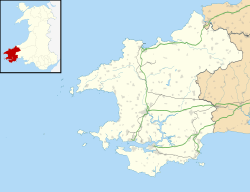
Back بيمبروكشاير Arabic Пембрукшыр Byelorussian Пембрукшър Bulgarian Sir Benfro Breton Sir Benfro Catalan Pembrokeshire CEB Pembrokeshire Czech Sir Benfro Welsh Pembrokeshire Danish Pembrokeshire German
Pembrokeshire
Sir Benfro (Welsh) | |
|---|---|
 Tenby in southeast Pembrokeshire | |
 Pembrokeshire shown within Wales | |
| Coordinates: 51°50′42″N 4°50′32″W / 51.84500°N 4.84222°W | |
| Sovereign state | United Kingdom |
| Country | Wales |
| Preserved county | Dyfed |
| Incorporated | 1 April 1996 |
| Administrative HQ | Haverfordwest |
| Government | |
| • Type | Principal council |
| • Body | Pembrokeshire County Council |
| • Control | No overall control |
| • MPs | 2 MPs
|
| • MSs | 2 MSs
|
| Area | |
| • Total | 625 sq mi (1,618 km2) |
| • Rank | 5th |
| Population (2022)[2] | |
| • Total | 124,367 |
| • Rank | 13th |
| • Density | 200/sq mi (77/km2) |
| Welsh language (2021) | |
| • Speakers | 17.2% |
| • Rank | 8th |
| Time zone | UTC+0 (GMT) |
| • Summer (DST) | UTC+1 (BST) |
| ISO 3166 code | GB-PEM |
| GSS code | W06000009 |
| Website | pembrokeshire |
Pembrokeshire (/ˈpɛmbrʊkʃɪər, -ʃər/ PEM-bruuk-sheer, -shər; Welsh: Sir Benfro [siːr ˈbɛnvrɔ]) is a county in the south-west of Wales. It is bordered by Carmarthenshire to the east, Ceredigion to the northeast, and otherwise by the sea.[note 1] Haverfordwest is the largest town and administrative headquarters of Pembrokeshire County Council.
The county is generally sparsely populated and rural, with an area of 610 square miles (1,600 km2) and a population of 123,400. After Haverfordwest, the largest settlements are Milford Haven (13,907), Pembroke Dock (9,753), and Pembroke (7,552). St Davids (1,841) is a city, the smallest by population in the UK. Welsh is spoken by 17.2 percent of the population, and for historic reasons is more widely spoken in the north of the county than in the south.
Pembrokeshire's coast is its most dramatic geographic feature, created by the complex geology of the area. It is a varied landscape which includes high sea cliffs, wide sandy beaches, the large natural harbour of Milford Haven, and several offshore islands which are home to seabird colonies. Most of it is protected by Pembrokeshire Coast National Park, and can be hiked on the 190-mile (310 km) Pembrokeshire Coast Path. The interior of Pembrokeshire is relatively flat and gently undulating, with the exception of the Preseli Mountains in the north.
There are many prehistoric sites in Pembrokeshire, particularly in the Preseli Mountains. During the Middle Ages several castles were built by the Normans, such as Pembroke and Cilgerran, and St David's Cathedral became an important pilgrimage site. During the Industrial Revolution the county remained relatively rural, with the exception of Milford Haven, which was developed as a port and Royal Navy dockyard. It is now the UK's third-largest port, primarily because of its two liquefied natural gas terminals. The economy of the county is now focused on agriculture, oil and gas, and tourism.
- ^ Cite error: The named reference
Council leadershipwas invoked but never defined (see the help page). - ^ a b "Mid-Year Population Estimates, UK, June 2022". Office for National Statistics. 26 March 2024. Retrieved 3 May 2024.
- ^ Cite error: The named reference
ONSJan2023was invoked but never defined (see the help page).
Cite error: There are <ref group=note> tags on this page, but the references will not show without a {{reflist|group=note}} template (see the help page).
